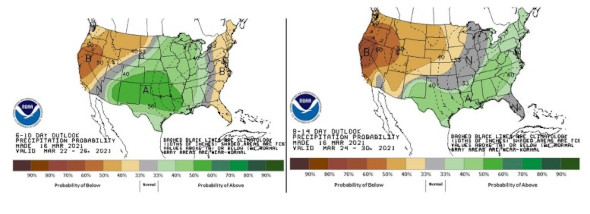By Bruce MacKellar
While the late summer and early fall of 2020 was certainly dry, when rainfall returned fields became extremely wet during late harvest. This allowed for the creation of deep ruts in some fields. Heavy rainfall also led to some erosion on fields that were tilled during dry conditions early last fall that will need to be addressed before planting this spring.
Ruts and rills need to be worked level to ensure good seed to soil contact before planting. But this is not the whole challenge. More problematic are the areas of compaction that lie beneath the ruts. It takes dry conditions and deep tillage to help shatter the compaction layers under normal circumstances. Growers often rely on dry conditions during early spring to reduce impacts from these problems. At least for the nearby period of mid-March of 2021, drying conditions may be hard to come by. The 6-10 outlook from NOAA is calling for higher than normal precipitation for the period. However, the 8-14 day outlooks from NOAA suggest a return to more normal precipitation for the end of the month.

Michigan State University Extension soybean educator
Mike Staton and MSU agriculture engineering specialist
Tim Harrigan published an excellent article, “
Repairing harvest ruts this spring” during the spring of 2020 that discusses ways to address some of these challenges. In summary, the article suggests fields should be 90-95% of field capacity (or drier) through the zone of tillage to be able to repair the ruts without risk of further compaction. Field capacity is when the soil drains to a state of equilibrium following a rainfall event.
In addition to tillage, establishing deep rooted cover crops can help to reduce compaction caused by harvest ruts. These covers are usually produced in combination with winter wheat in the rotation. Establishment immediately following winter wheat harvest allows enough time for the roots of the brassica components of a cover crop mix to work their way into the compaction zones, breaking up the layers and adding carbon back into the soil for subsequent seasons. While you can’t use this system to fix fields damaged last fall this spring (too late to plant wheat), it can be an important strategy to keep in mind for future years to help address soil compaction.
MSU Extension’s cover crop team has extensive resources about which cover crops work the best in various situations.